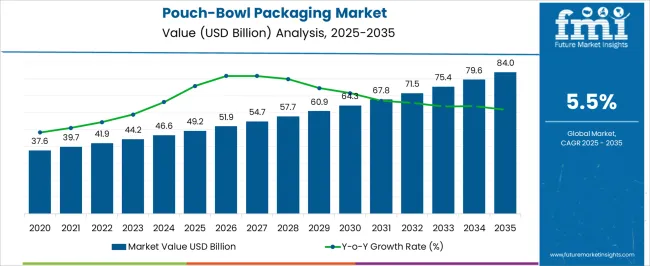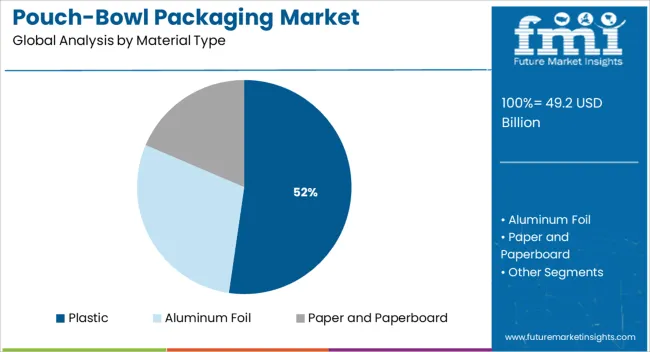The Pouch-Bowl Packaging Market is estimated to be valued at USD 49.2 billion in 2025 and is projected to reach USD 84.0 billion by 2035, registering a compound annual growth rate (CAGR) of 5.5% over the forecast period.

| Metric | Value |
|---|---|
| Pouch-Bowl Packaging Market Estimated Value in (2025 E) | USD 49.2 billion |
| Pouch-Bowl Packaging Market Forecast Value in (2035 F) | USD 84.0 billion |
| Forecast CAGR (2025 to 2035) | 5.5% |
The pouch bowl packaging market is undergoing notable transformation as demand rises for lightweight, portable, and shelf-ready packaging formats. Shifting consumer lifestyles, the acceleration of on-the-go consumption, and the need for extended shelf life are driving adoption across food, beverage, and pet care applications. Packaging manufacturers are optimizing formats that provide high barrier protection, resealability, and microwave compatibility to meet evolving consumer expectations.
At the same time, regulatory pressure to reduce packaging waste is accelerating the transition toward recyclable materials and mono-material constructions. The combination of aesthetic appeal, functionality, and operational efficiency has encouraged retailers and brand owners to standardize pouch bowl packaging across various SKUs.
Future market momentum is expected to build around the integration of bio-based films, digital printing for mass personalization, and recyclable laminates that support brand storytelling and compliance. Strategic investments in automated pouching lines and material R&D will further reinforce scalability and innovation across global supply chains.
The market is segmented by Material Type, Product Type, Form, and Application and region. By Material Type, the market is divided into Plastic, Aluminum Foil, and Paper and Paperboard. In terms of Product Type, the market is classified into Stand Up Pouches, Back-Seal Quad, Spouted Pouches, and Gusseted Pouches. Based on Form, the market is segmented into Flexible, Rigid, and Semi-Rigid. By Application, the market is divided into Food, Beverages, and Pharmaceutical. Regionally, the market is classified into North America, Latin America, Western Europe, Eastern Europe, Balkan & Baltic Countries, Russia & Belarus, Central Asia, East Asia, South Asia & Pacific, and the Middle East & Africa.

Plastic is anticipated to dominate the material type segment with a projected 52.3% share of total revenue in 2025. This leadership is primarily supported by the material's cost efficiency, high barrier properties, and compatibility with advanced converting processes.
Plastic materials enable heat sealing, high-clarity printing, and structural integrity under varying environmental conditions, which makes them particularly well-suited for both food and liquid packaging in pouch bowl formats. Technological innovations in recyclable and mono-layer plastic films have also improved environmental acceptability without compromising performance.
The widespread availability of resin types such as polyethylene and polypropylene has facilitated scalability and consistent supply across global manufacturing networks. Additionally, plastic's adaptability in form-fill-seal operations and its ability to support lightweighting strategies have further reinforced its strong position in the pouch bowl packaging landscape.

Stand up pouches are expected to contribute 39.7% of the total market revenue in 2025 under the product type category, positioning them as the dominant configuration. This is largely attributed to their strong shelf presence, convenient usability, and efficient storage benefits.
Their gusseted bottom design provides self-supporting structure, making them ideal for retail display without secondary packaging. The growing preference for resealable closures and easy-tear openings has also increased their adoption in ready-to-eat meals, beverages, and personal care products.
Advances in lamination technology and compatibility with digital printing have made stand up pouches highly customizable, aligning with brand marketing goals and regulatory labeling requirements. Their lighter weight compared to rigid containers significantly reduces transportation costs and carbon footprint, which has further strengthened their appeal in both developed and emerging markets.

Flexible form is forecast to account for 64.2% of total market revenue in 2025, making it the leading format in the pouch bowl packaging market. Its dominance is supported by growing demand for compact, portable, and resealable packaging formats that align with convenience-driven consumption patterns. Flexible packaging allows brand owners to minimize material usage while maximizing functionality, including tamper evidence, easy dispensing, and multi-layer protection.
The ability to form fit product dimensions improves shelf space utilization and reduces packaging waste. Additionally, advancements in flexible film structures have enabled high-speed filling and sealing, increasing production throughput without compromising integrity.
As consumer awareness around sustainable packaging increases, flexible pouches that offer recyclability or compostability are gaining momentum. These dynamics have made flexible formats the go-to solution across multiple end-use categories, reinforcing their market-leading position.
Packaging has become a vital component of modern life due to the ease of transportation, storage and inclination of the consumer towards fascinating packaging products. Moreover, Packaging industry through its number of innovation has bought a revolutionary change in food beverages industry.
Pouch-bowl packaging is one of the effective packaging solutions that provides all the feature related to high performance during transportation storage and provide moisture, corrosion and shielding protection for sensitive products and components.
Generally, pouch-bowl packaging is designed for foods that can be heated in and eaten from the package. This pouch can hold dry as well as wet food such as cereals, yoghurt and snacks. The cost competitiveness coupled with superior packaging quality is expected to encourage a significant growth in the pouch-bowl packaging market over the forecast period.
Growth in demand for Pouch-Bowl Packaging market is expected to grow strongly for several reasons. Due to speedy urbanization and industrialization the Pouch-Bowl Packaging market is undergoing technological advancements.
Other than that rising use of Pouch-Bowl Packaging in food and beverage industry especially for ready to eat and ready to drink products is significantly fuelling this market. Moreover, these pouch-bowl packaging comes in a wide range of custom material, shapes and size, giving the packaging an attractive and aesthetic look.
Additionally, Pouch bowl packaging features high quality rotogravure and flexography printing that helps the manufacturer to enhance and support consumer product branding. Increasing working population and growing online sales is further expected to drive the demand for pouch-bowl packaging over the forecast period.
However, the high cost of pouch-bowl packaging is considered as a restraining factor towards the growth of Pouch-Bowl Packaging market. Furthermore, the usage of heat seal bags is expected to hinder the growth of Pouch-Bowl Packaging market due to its non-reusable nature.
Geographically, the Pouch-Bowl Packaging market can be segmented into North America, Latin America, Europe, Asia-Pacific (APAC) and Middle East Africa (MEA). The growth of global Pouch-Bowl Packaging market is expected to witness a healthy CAGR over the forecast period of 2020-2025.
Moreover, Asia-Pacific is expected to witness a high growth of Pouch-Bowl Packaging market due to the rising consumption of food products. The demand of the Pouch-Bowl Packaging market is expected to witness an above average growth in North America due to the higher adoption of Pouch-Bowl Packaging for commercial and industrial use.
Some of the major players identified across the globe in the Pouch-Bowl Packaging market are Ampac Holding, LLC, Kapak Corporation, Cryovac Inc., Exopack LLC, Huhtamaki Group, Bemis Company Inc, Sucat Packaging.
The research report presents a comprehensive assessment of the market and contains thoughtful insights, facts, historical data, and statistically supported and industry-validated market data. It also contains projections using a suitable set of assumptions and methodologies. The research report provides analysis and information according to market segments such as geography type, material type, closure type, by end use.
The report is a compilation of first-hand information, qualitative, and quantitative assessment by industry analysts, inputs from industry experts and industry participants across the value chain. The report provides in-depth analysis of parent market trends, macro-economic indicators and governing factors along with market attractiveness as per segments. The report also maps the qualitative impact of various market factors on market segments and geographies.
The global pouch-bowl packaging market is estimated to be valued at USD 49.2 billion in 2025.
The market size for the pouch-bowl packaging market is projected to reach USD 84.0 billion by 2035.
The pouch-bowl packaging market is expected to grow at a 5.5% CAGR between 2025 and 2035.
The key product types in pouch-bowl packaging market are plastic, aluminum foil and paper and paperboard.
In terms of product type, stand up pouches segment to command 39.7% share in the pouch-bowl packaging market in 2025.






Our Research Products

The "Full Research Suite" delivers actionable market intel, deep dives on markets or technologies, so clients act faster, cut risk, and unlock growth.

The Leaderboard benchmarks and ranks top vendors, classifying them as Established Leaders, Leading Challengers, or Disruptors & Challengers.

Locates where complements amplify value and substitutes erode it, forecasting net impact by horizon

We deliver granular, decision-grade intel: market sizing, 5-year forecasts, pricing, adoption, usage, revenue, and operational KPIs—plus competitor tracking, regulation, and value chains—across 60 countries broadly.

Spot the shifts before they hit your P&L. We track inflection points, adoption curves, pricing moves, and ecosystem plays to show where demand is heading, why it is changing, and what to do next across high-growth markets and disruptive tech

Real-time reads of user behavior. We track shifting priorities, perceptions of today’s and next-gen services, and provider experience, then pace how fast tech moves from trial to adoption, blending buyer, consumer, and channel inputs with social signals (#WhySwitch, #UX).

Partner with our analyst team to build a custom report designed around your business priorities. From analysing market trends to assessing competitors or crafting bespoke datasets, we tailor insights to your needs.
Supplier Intelligence
Discovery & Profiling
Capacity & Footprint
Performance & Risk
Compliance & Governance
Commercial Readiness
Who Supplies Whom
Scorecards & Shortlists
Playbooks & Docs
Category Intelligence
Definition & Scope
Demand & Use Cases
Cost Drivers
Market Structure
Supply Chain Map
Trade & Policy
Operating Norms
Deliverables
Buyer Intelligence
Account Basics
Spend & Scope
Procurement Model
Vendor Requirements
Terms & Policies
Entry Strategy
Pain Points & Triggers
Outputs
Pricing Analysis
Benchmarks
Trends
Should-Cost
Indexation
Landed Cost
Commercial Terms
Deliverables
Brand Analysis
Positioning & Value Prop
Share & Presence
Customer Evidence
Go-to-Market
Digital & Reputation
Compliance & Trust
KPIs & Gaps
Outputs
Full Research Suite comprises of:
Market outlook & trends analysis
Interviews & case studies
Strategic recommendations
Vendor profiles & capabilities analysis
5-year forecasts
8 regions and 60+ country-level data splits
Market segment data splits
12 months of continuous data updates
DELIVERED AS:
PDF EXCEL ONLINE
Packaging Supply Market Size and Share Forecast Outlook 2025 to 2035
Packaging Testing Services Market Size and Share Forecast Outlook 2025 to 2035
Packaging Tubes Market Size and Share Forecast Outlook 2025 to 2035
Packaging Jar Market Forecast and Outlook 2025 to 2035
Packaging Barrier Film Market Size and Share Forecast Outlook 2025 to 2035
Packaging Films Market Size and Share Forecast Outlook 2025 to 2035
Packaging Laminate Market Size and Share Forecast Outlook 2025 to 2035
Packaging Burst Strength Test Market Size and Share Forecast Outlook 2025 to 2035
Packaging Tapes Market Analysis - Size, Share, & Forecast Outlook 2025 to 2035
Packaging Materials Market Size and Share Forecast Outlook 2025 to 2035
Packaging Labels Market Size and Share Forecast Outlook 2025 to 2035
Packaging Equipment Market Size and Share Forecast Outlook 2025 to 2035
Packaging Resins Market Size and Share Forecast Outlook 2025 to 2035
Packaging Inspection Systems Market Size and Share Forecast Outlook 2025 to 2035
Packaging Design And Simulation Technology Market Size and Share Forecast Outlook 2025 to 2035
Packaging Suction Cups Market Size and Share Forecast Outlook 2025 to 2035
Packaging Straps and Buckles Market Size and Share Forecast Outlook 2025 to 2035
Packaging Coating Market Analysis - Size, Share, & Forecast Outlook 2025 to 2035
Packaging Testing Equipment Market Analysis & Growth 2025 to 2035
Packaging Bins Market Trends - Growth & Demand 2025 to 2035

Thank you!
You will receive an email from our Business Development Manager. Please be sure to check your SPAM/JUNK folder too.
Chat With
MaRIA